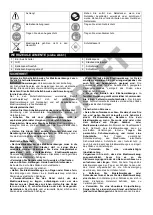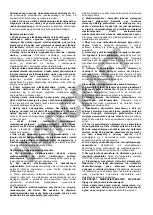
●
Do not abuse the cord. Never use the cord for carrying, pulling
or unplugging the power tool. Keep cord away from heat, oil,
sharp edges and moving parts. Damaged or entangled cords
increase the risk of electric shock.
●
When operating a power tool outdoors, use an extension cord
suitable for outdoor use. Use of a cord suitable for outdoor use
reduces the risk of electric shock.
●
If operating a power tool in a damp location is unavoidable,
use a residual current device (RCD) protected supply. Use of an
RCD reduces the risk of electric shock.
Personal safety
●
Stay alert, watch what you are doing and use common sense
when operating a power tool. Do not use a power tool while you
are tired or under the influence of drugs, alcohol or medication. A
moment of inattention while operating power tools may result in
serious personal injury.
●
Use personal protective equipment. Always wear eye
protection. Protective equipment such as dust mask,
non-skid safety shoes, hard hat, or hearing protection used for
appropriate conditions will reduce personal injuries.
●
Prevent unintentional starting. Ensure the switch is in
the off-position before connecting to power source and/or battery
pack, picking up or carrying the tool.
Carrying power tools with your finger on the switch or energizing
power tools that have the switch on invites accidents.
●
Remove any adjusting key or wrench before turning
the power tool on. A wrench or a key left attached to a rotating
part of the power tool may result in personal injury.
●
Do not overreach. Keep proper footing and balance at all times.
This enables better control of the power tool in unexpected
situations.
●
Dress properly. Do not wear loose clothing or jewellery. Keep
your hair, clothing and gloves away from moving parts. Loose
clothes, jewellery or long hair can be caught in moving parts.
●
If devices are provided for the connection of dust extraction and
collection facilities, ensure these are connected and properly
used. Use of dust collection can reduce dust-related hazards.
Power tool use and care
●
Do not force the power tool. Use the correct power tool for your
application. The correct power tool will do the job better and safer
at the rate for which it was designed.
●
Do not use the power tool if the switch does not turn it
on and off. Any power tool that cannot be controlled with the
switch is dangerous and must be repaired.
●
Disconnect the plug from the power source and/or the
battery pack from the power tool before making any adjustments,
changing accessories, or storing power tools. Such preventive
safety measures reduce the risk of starting the power tool
accidentally.
●
Store idle power tools out of the reach of children and do not
allow persons unfamiliar with the power tool or these instructions
to operate the power tool. Power tools are dangerous in the hands
of untrained users.
●
Maintain power tools. Check for misalignment or binding of
moving parts, breakage of parts and any other condition that may
affect the power tool
’s operation. If damaged, have the power tool
repaired before use. Many accidents are caused by poorly
maintained power tools.
●
Keep cutting tools sharp and clean. Properly maintained cutting
tools with sharp cutting edges are less likely to bind and are easier
to control.
●
Use the power tool, accessories and tool bits etc. in accordance
with these instructions, taking into account the working conditions
and the work to be performed. Use of the power tool for
operations different from those intended could result in a
hazardous situation.
●
Keep handles and grasping surfaces dry, clean and
free from oil and grease. Slippery handles and grasping
surfaces do not allow for safe handling and control of the
tool in unexpected situations.
Use and handling of the cordless electrical power
tool
a) Charge a rechargeable battery using only the charger
recommended by the manufacturer. Chargers are often
designed for a particular type of rechargeable battery
unit. There is a risk of fire if a battery charger specified
for a particular type of battery is used with other
batteries.
b) Only the rechargeable battery units supplied are to be
used with an electrical power tool. The use of other
rechargeable battery units may lead to the danger of
injury or fire.
c) When they are not being used, store rechargeable
battery units away from paperclips, coins, keys, nails,
screws or other small metal objects that could cause the
contacts to be bridged. Short-circuiting the contacts of a
rechargeable battery unit may result in heat damage or
fire.
d) Fluids may leak out of rechargeable battery units if
they are misused. If this happens, avoid contact with the
fluid. If contact occurs, flush the affected area with water.
Seek additional medical help if any of the fluid gets into
your eyes. Escaping battery fluid may cause skin
irritation or burns.
e) Do not use damaged or modified batteries. Damaged
or modified batteries may behave unexpectedly and
cause fires, explosions or pose a risk of injury.
f) Do not expose a battery to fire or excessively high
temperatures. Fire or temperatures in excess of 130
°C
(265
°F) can cause an explosion.
g) Follow all instructions regarding charging and never
charge the battery or the cordless tool outside of the
temperature range given in the operating instructions.
Incorrect charging or charging outside of the permissible
temperature range can destroy the battery and increase
the risk of fire.
CAUTION! RISK OF EXPLOSION!
Never charge non-rechargeable batteries.
Protect the rechargeable battery from heat (for example,
from continuous exposure to sunlight), fire, water and
moisture. There is a risk of explosion.
Service
●
Have your power tool serviced by a qualified repair
person using only identical replacement parts. This will
ensure that the safety of the power tool is maintained.
●
Never try to repair damaged batteries. Batteries
should only be maintained by the manufacturer
or an approved customer service centre.
Safety guidelines for battery chargers
●
This appliance may be used by children aged 8 years
and above and by persons with limited physical, sensory
or mental capabilities or lack of experience and
knowledge, provided that they are under supervision or
have been told how to use the appliance safely and are
aware of the potential risks. Do not allow children to use
the appliance as a toy. Cleaning and user maintenance
tasks may not be carried out by children unless they are
supervised.
●
To avoid potential risks, damaged mains cables should
Содержание CPMS-S20Li
Страница 2: ......
Страница 3: ......
Страница 13: ......
Страница 23: ......
Страница 39: ...Descriere detaliat CPMS S20Li...
Страница 41: ......
Страница 54: ...Exploded view CPMS S20Li...












































